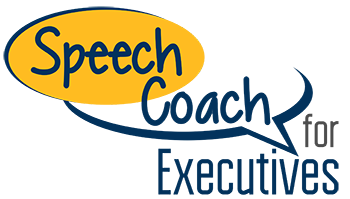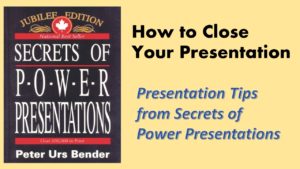How to Close Your Speech or Presentation
Closing Your Speech
(This is an excerpt from Secrets of Power Presentations – the bestselling book by Peter Urs Bender)
As with your opening and, like a flight, your presentation should have a smooth conclusion that neatly ties everything together. I recommend that you do not read your closing statement from notes. Do have it ready in case you have a “brown out”. However, to ensure sincerity, your closing should come from within as much as possible. The delivery, if not the content, should appear spontaneous.
Your close although short is a significant part of your speech. Be clear on the purpose of your speech and be clear on how your close supports that purpose. Your last words might be remembered the most.
No matter how badly you think your presentation went always end it looking and sounding confidently.
How to End a Speech
Here are nine effective ways to end your speech that you can prepare. Rehearse so you can deliver the close sounding and looking natural and confident.
Summarize Your Presentation
Reiterate your objective in speaking and demonstrate that you have fulfilled that purpose. End with things like,
“In summary, there are five ways we can keep our customers forever” or “In conclusion, there are three points I want to summarize…”.
Close with an Anecdote
The story should tie everything together and exemplify the kind of action or behaviour you expect from your listener as a result of your presentation.
Use one which effectively illustrates your most important point and makes the audience feel good.
End with a Call to Action
Tell the audience exactly what you want them to do. This is critical yet so many just assume that the listeners will know what to do. Some speakers feel that a call to action insults the audience’s intelligence. On the contrary, the call to action removes any doubt as to what you are trying to communicate to them. Here are some examples:
“Start today to sincerely compliment your employees if you want to increase productivity in your department”
“Phone your local community college today and register for a course in public speaking…”
“Tonight, ask your children about their life goals and listen to them without passing judgment”.
Tell the audience exactly what they can do in reaction to your speech. Leave them feeling in control.
Ask a Rhetorical Question
This is one which does not demand an answer so much as reflection on the part of the audience. A rhetorical question should provoke thought. For example:
“Where would our company be without the work, effort and dedication of our employees?
“What would we do if we lost our largest client?”
“Where would our company be without our five biggest customers?”
Make a Statement
In a technical presentation or possibly a press conference, a simple, straightforward concluding statement is all that is necessary to draw your presentation to a close. For example,
“There is much to be learned in this rapidly expanding area of behavioural research into effective employer/employee relations. I’ve covered just a small part of it. I hope that each of you will take time to learn more…”
End the Same Way You Began
This is a popular movie-making technique. It gives symmetry to your presentation. You can close with the same anecdote or quotation with which you opened and show that you have come full circle. For example:
“As quoted from F.D.R. at the beginning of my presentation “We have nothing to fear but fear itself”…”
“I will end where I began. Our customers are Number One. Without them, we would not exist…”
Show Them an Outline of Your Completed Presentation
Similar to the above “bookends” approach, this technique neatly and concisely summarizes everything you have tried to cover and smoothly leads the way to questions from the audience.
“In closing my presentation…”
This regains the attention of the listeners and sets you up to make a summary statement or call to action. Although it may sound amateurish it is a good way to keep the audience awake on a sleeper topic. You might even say it a few times in the middle of your presentation if you see heads nodding off!
“I want to leave you with…”
Using this technique, you are giving your listeners something more; an idea, a piece of advice. Make it useful and be sure that it leaves them feeling good.
Finish Powerfully!
Above all, when you conclude your presentation, smile with all of your pride – stand tall. Walk slowly to your seat and look as confident as you can. Even if you screwed up, you are probably the only one who noticed! But when you have finished, everyone will watch you again and judge you by the way you returned confidently to your seat. So, keep your shoulders back, your chin up and smile!
My principal message in this book is that communicating to a business audience is much more than simply giving a speech. You must present yourself and your ideas in total. This is one of the secrets to power presentations.
Leave them laughing. . .
Leave them crying. . .
Leave them with hope. . .
But please do not just
Leave them. . .
Peter Urs Bender, author of the bestselling book on presentation skills, Secrets of Power Presentations
How to Close Your Speech or Presentation
George Torok was the first licensee of Power Presentations.
—–

